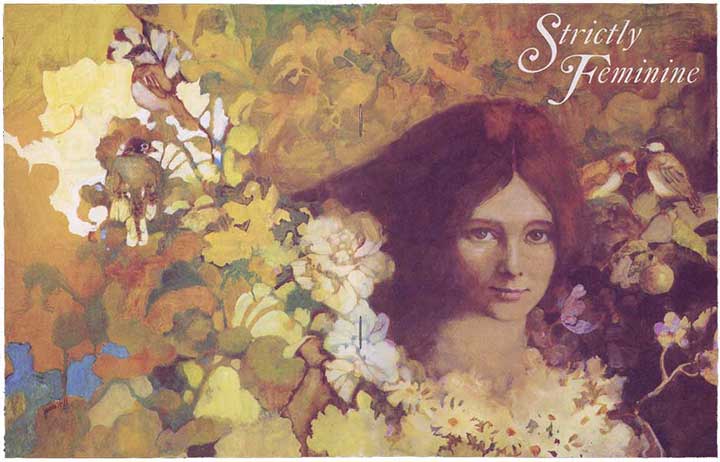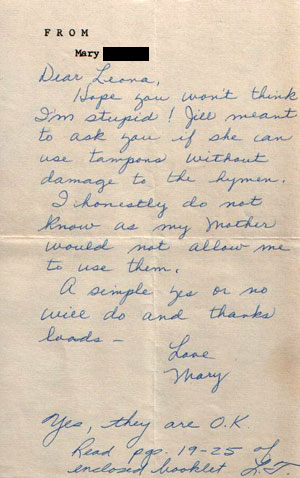See a Kotex ad
advertising a Marjorie May booklet.
See many more similar booklets.
See ads for
menarche-education booklets: Marjorie May's Twelfth
Birthday (Kotex, 1932), Tampax tampons (1970,
with Susan Dey), Personal
Products (1955, with Carol Lynley),
and German o.b.
tampons (lower ad, 1981)
And read Lynn Peril's series about
these and similar booklets!
Read the full text of the 1935 Canadian edition
of Marjorie May's Twelfth Birthday, probably
identical to the American edition.
More ads for teens (see also introductory page
for teenage advertising): Are you in the know? (Kotex napkins and Quest
napkin powder, 1948, U.S.A.), Are you in the know? (Kotex napkins and belts,
1949, U.S.A.)Are
you in the know?
(Kotex napkins, 1953, U.S.A.), Are you in the know? (Kotex napkins and belts,
1964, U.S.A.), Freedom (1990, Germany), Kotex (1992, U.S.A.), Pursettes (1974, U.S.A.), Pursettes (1974, U.S.A.), Saba (1975, Denmark)
See early tampons
and a list of tampon
on this site - at least the ones I've
cataloged.


|

Strictly
Feminine, menstruation
and puberty booklet for teenage
girls (1969, U.S.A., The Personal
Products Co., maker of Modess
pads)
complete
booklet
with a letter from a mother to
her daughter's doctor
Apparently one of the most
common questions girls and parents
asked when about to use tampons
was, "Um, how 'bout the hymen?" -
in other words, about virginity.
People opposed tampons right from
the beginning partly because of
this and do today, for example in
Hispanic cultures, as Tambrands
and Procter & Gamble found
out in the 1990s when trying to
increase tampon use in Mexico
(scoll to third item down).
The
undated letter below
possibly comes from a mother whose
daughter was a patient in the
Children's Rehabilitation Unit at
the University of Kansas Medical
Center, Kansas City: that
organization is stamped on the
inside front cover (not shown) of
the booklet below. The letter,
below, in an undated envelope (not
shown) came with the booklet when
a Dutchman bought them at auction.
The doctor - Leona's title on the
envelope is "Dr." - addressed the
envelope to the writer of the
letter and stamped it PERSONAL. I
find it interesting that the
writer called the doctor by her
first name and signed it "Love."
Her daughter could have been in
rehabilitation long enough to
allow a close relationship to
develop.
What happened is just what the
maker of the booklet, the Modess
menstrual pad and tampon
manufacturer, wanted: to have a
medical figure give the booklet to
a patient rather than deliver the
explanation herself. Since at
least the 1920s menstrual products
companies have used puberty
education booklets to promote
their products; see an example here from
1928 and many more here.
I think the title seeks to
reinforce the idea of femininity -
"daintiness" in the words of so
many ads - to combat some of the
things that many women hate about
menstruation.
I thank the Dutch contributor
for the scan of the letter!
|
Below:
The back (at left) and front
covers. The
34-page booklet measures 13.5 x
17.5 cm (5.25 x 6.87").
|
 |
Below:
A letter the Dutch contributor
found in his copy of this booklet.
I blacked out the name of the
writer. See the pages the doctor
recommended.
|
 |
© 2007 Harry Finley. It is illegal to
reproduce or distribute any of the work on
this Web site in any manner
or medium without written permission of the
author. Please report suspected violations
to hfinley@mum.org
|